Fat cells, also known as adipocytes or adipose cells, are specialized cells that play an essential role in energy storage and metabolism.
These cells are the building blocks of adipose tissue, a type of connective tissue located mainly beneath the skin, between muscle layers, and surrounding vital internal organs.
Fat cells are more than just storage units for fat. Recent research has revealed that these cells have many other important functions in the body. They help regulate metabolism, secrete hormones, keep our bodies warm, and even protect our organs by providing cushioning.
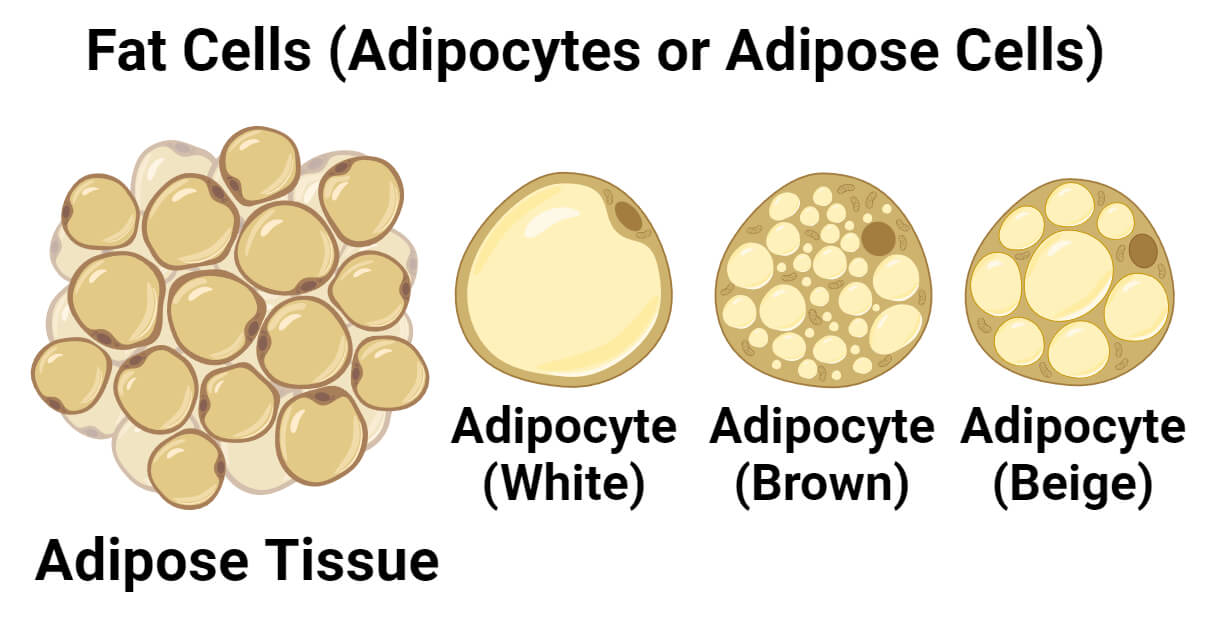
The rise in obesity rates, caused by inactive lifestyles and eating high-calorie foods, presents a significant health challenge globally. This surge in obesity is concerning due to its association with several diseases, including type 2 diabetes, heart disease, insulin resistance, hypertension, and cancers. Studying fat cells, how they work, their types, and functions could be the answer to fighting obesity and other related metabolic disorders.
Interesting Science Videos
Types of Fat Cells (Adipocytes)
There are different types of fat cells found in different parts of the body with specific functions. The two main types of fat cells include white fat cells and brown fat cells. In addition to these well-known types, there are also beige and pink fat cells which have intermediate characteristics between white and brown fat cells.
1. White Fat Cells
- White fat cells or white adipocytes are the most common fat cells in the body. They are distributed throughout the body, particularly under the skin and in the abdominal region.
- White fat cells are specialized for fat storage and act as the primary energy reserve within the body.
- The main function of white fat cells is to store excess energy in the form of triglycerides, which are molecules composed of glycerol and three fatty acid chains.
- White fat cells also play an essential role in maintaining metabolic health by regulating energy balance and metabolism through the secretion of various signaling molecules.
- They also play an important role in energy balance, metabolism, and hormone regulation, but excessive accumulation can lead to complications associated with excess fat storage and metabolic disorders such as type 2 diabetes, obesity, and insulin resistance.
2. Brown Fat Cells
- Brown fat cells, also known as brown adipocytes, are fat cells that are found in areas such as the neck, collarbone, and surrounding internal organs.
- The majority of brown fat cells originate from precursor cells found in the embryonic mesoderm.
- Brown fat cells are specialized for thermogenesis, a process where chemical energy from glucose and lipids is converted into heat, particularly in response to cold exposure.
- Brown fat cells are rich in mitochondria containing a protein called uncoupling protein-1 (UCP1). When activated, UCP1 disrupts the electrochemical gradient that drives ATP synthesis. This disruption leads to an increase in respiratory chain activity and the combustion of substrates, such as glucose and fatty acids, to produce heat.
- The high density of mitochondria gives them a distinctive brown color due to increased heat production.
- Dysfunction in brown fat cells can impact thermogenesis, potentially leading to imbalances in metabolic health causing obesity and other related metabolic disorders.
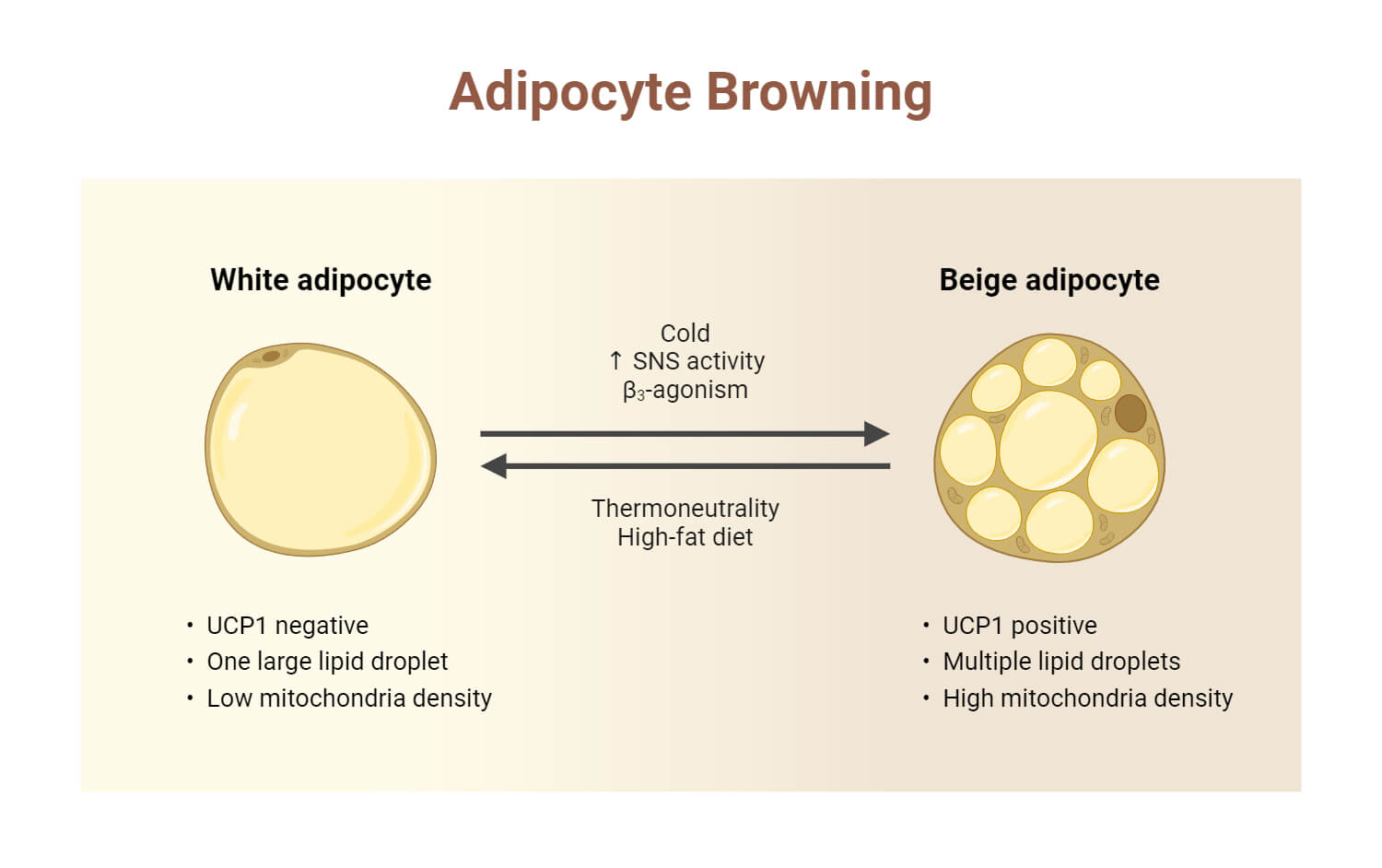
https://doi.org/10.3390/cells8080795 and Ro, S.-H., Jang, Y., Bae, J., Kim, I. M., Schaecher, C., & Shomo, Z. D. (2019). Autophagy in Adipocyte Browning: Emerging Drug Target for Intervention in Obesity. Frontiers in Physiology, 10, 22. https://doi.org/10.3389/fphys.2019.00022
3. Beige Fat Cells
- Beige fat cells, also known as Brite (brown in white adipose tissue) cells, are a type of fat cells that develop within white adipose tissue (WAT) in response to stimuli like cold exposure.
- Under certain conditions, white fat cells can transform into cells that express UCP1 protein and have energy-burning properties similar to brown fat cells.
- Initially, these UCP1+ cells within WAT were thought to be brown fat cells but are now recognized as beige fat cells.
- The origin and developmental lineage of beige adipocytes are still an area of ongoing research, with some distinctions from brown adipocytes.
- These cells originate from white fat cells through a process called browning and behave like brown fat cells. So, these fat cells have properties of both white and brown fat cells.
- While both brown and beige adipocytes can undergo thermogenesis, they exhibit distinct characteristics, so they should be regarded as separate cell types.
4. Pink Fat Cells
- Pink fat cells were initially observed in female mice during late pregnancy and throughout lactation.
- These cells are found in the subcutaneous white adipose tissue and are distinct in appearance.
- Research suggests that pink fat cells are derived from white fat cells that undergo reversible transdifferentiation in rodents. However, it is still uncertain whether pink fat cells also develop in humans.
- The functions of pink adipocytes are not well studied, but they are believed to be involved in metabolic activities and possibly thermogenesis.
Anatomy and Structure of Fat Cells (Adipocytes)
- The structure of all fat cells contains a thin layer of cytoplasm and a plasma membrane surrounding a large lipid droplet.
- Observing fat cells under a microscope reveals spherical shapes filled with droplets of stored triglycerides.
- Within each cell, there are organelles including the nucleus, mitochondria, ribosomes, Golgi apparatus, and endoplasmic reticulum.
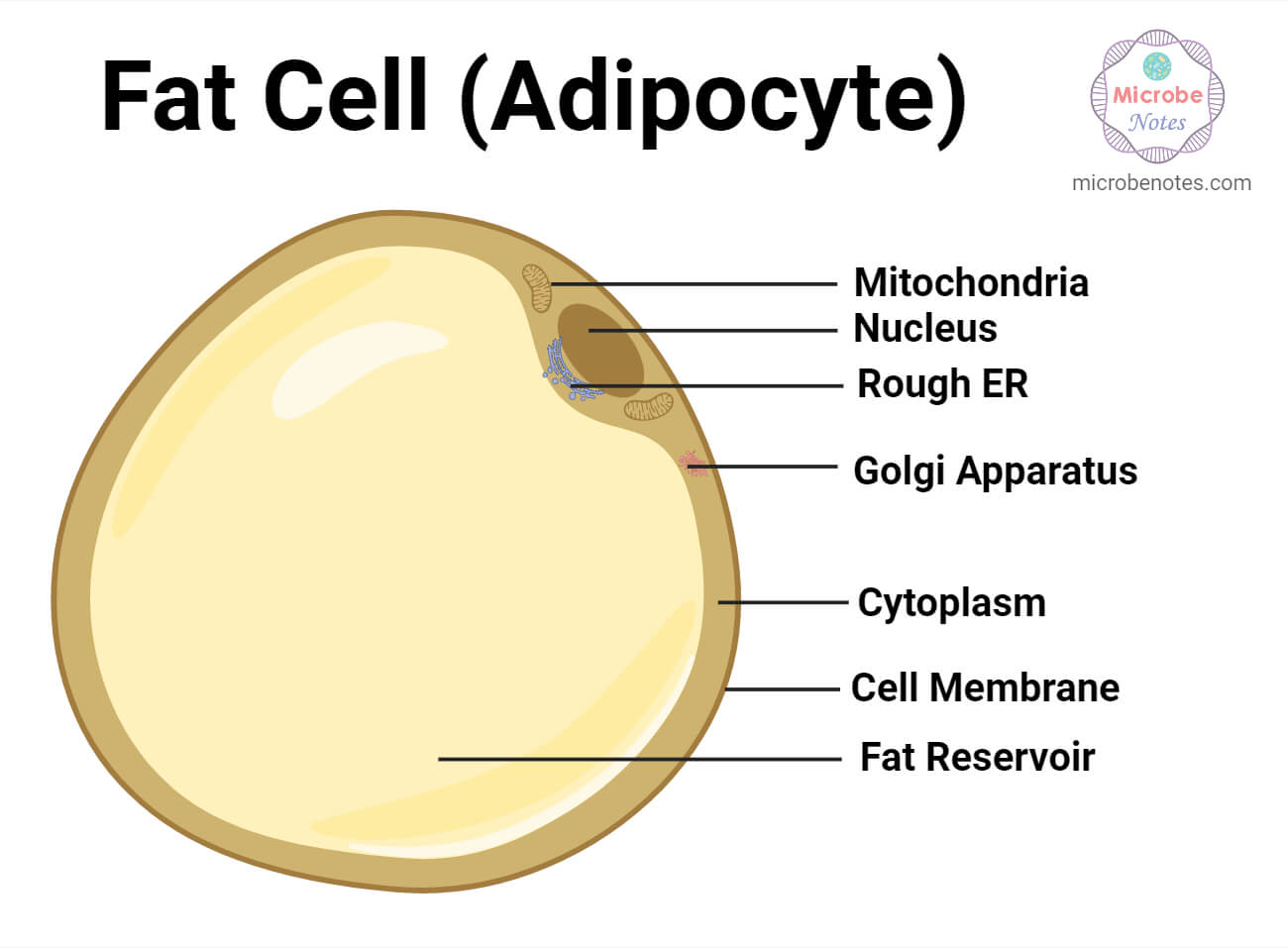
- White fat cells are round in shape with a single large lipid droplet. These cells are found in the white adipose tissue and are characterized by few mitochondria.
- Brown fat cells are smaller and contain multilocular or multiple small lipid droplets within each cell. These cells are characterized by lots of mitochondria which makes them darker in colour.
- Beige fat cells exhibit properties of both white and brown fat cells. These cells originate from white fat cells but function similarly to brown fat cells by generating heat through thermogenesis. They have a similar structure to brown fat cells including the multilocular appearance and the presence of abundant mitochondria that express proteins like UCP1.
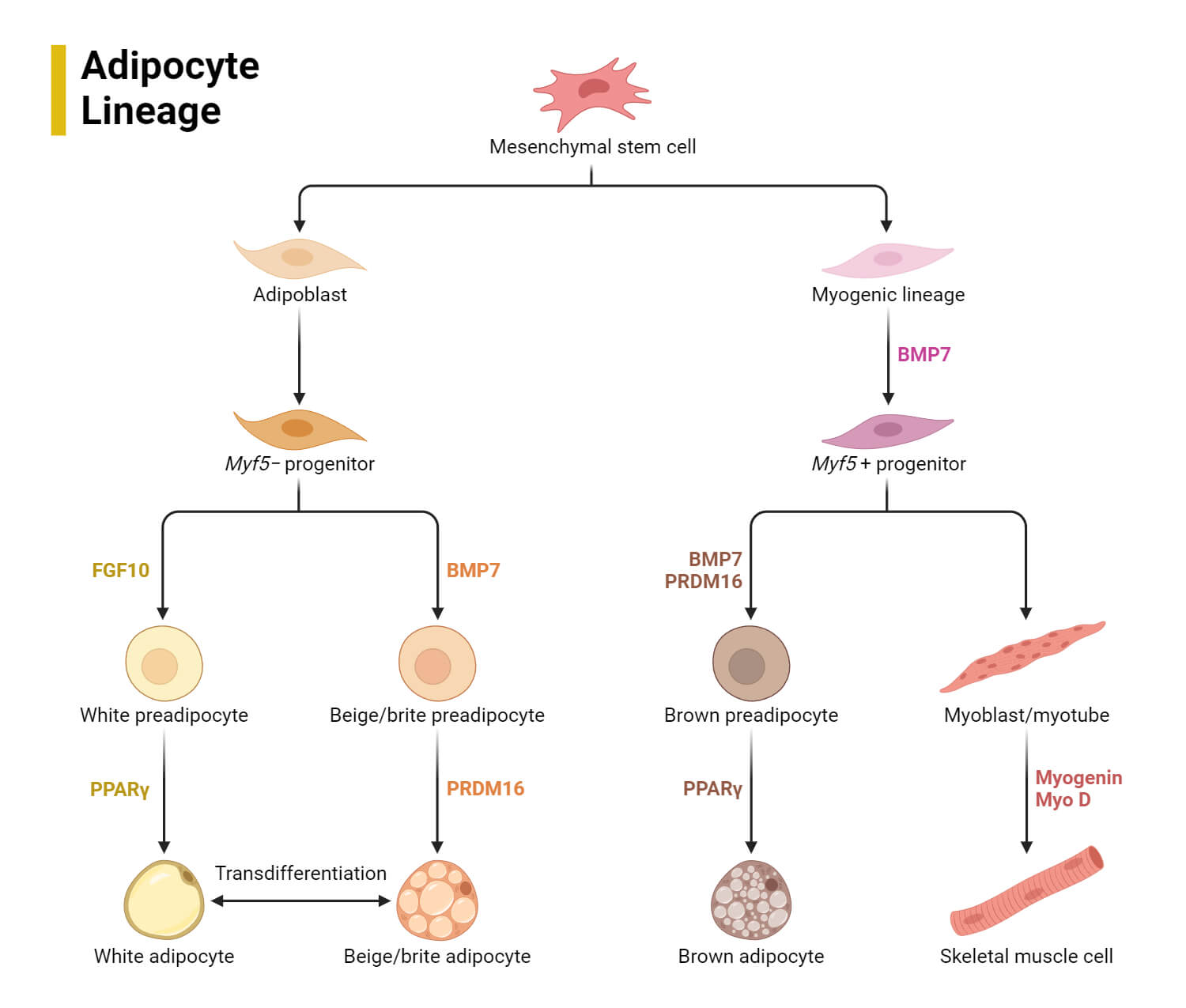
Functions of Fat Cells (Adipocytes)
- White fat cells store energy in the form of triglycerides. These cells convert excess energy from glucose into lipids, which are then stored for future use.
- When there is an energy deficit, such as during fasting or increased physical activity, white fat cells can break down the stored triglycerides into fatty acids and glycerol. These fatty acids are released into the bloodstream and can be used as a source of energy.
- White fat cells also produce signaling molecules that help regulate appetite and maintain energy balance within the body.
- Brown fat cells generate heat in response to cold exposure through the process of thermogenesis. This helps to maintain a stable body temperature.
- Brown fat cells and beige fat cells have metabolic benefits beyond thermogenesis. They can contribute to energy expenditure and help to regulate glucose and lipid metabolism.
- Brown and beige fat cells have therapeutic potential and can be used to combat obesity and several metabolic disorders.
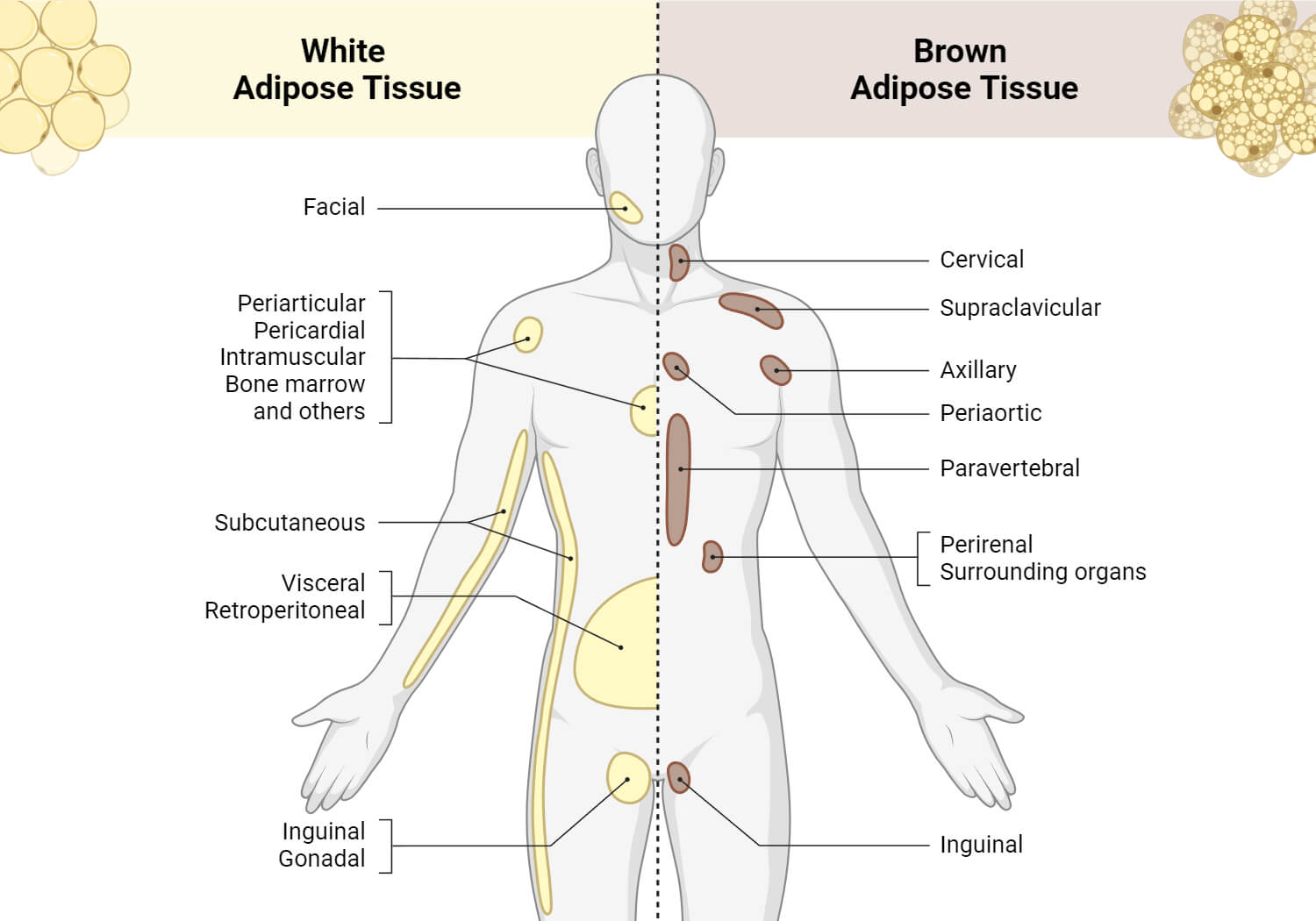
Diseases and Disorders of Fat Cells (Adipocytes)
- Lipodystrophy is a group of rare disorders where the body lacks normal fat tissue in specific parts of the body. This can be genetic or acquired, with some types linked to certain medications. The loss of fat tissue can lead to metabolic complications and serious health issues like diabetes, high cholesterol, and liver disease. People with lipodystrophy have low levels of hormones like leptin and adiponectin which control weight, metabolism, insulin sensitivity, inflammation, and lipid metabolism. Treatments focus on managing symptoms with diet, exercise, and medications.
- Lipoma is a benign growth of fat cells under the skin, usually appearing as a soft and painless lump. They are round or oval-shaped and vary in size from 1 to 10 cm. Lipomas can develop in various parts of the body, with common locations including the back, trunk, arms, shoulders, neck, and forehead. Although usually harmless, lipomas can cause discomfort if they press against nerves or near joints and can be removed.
- Liposarcoma is a rare type of cancer originating from fat cells found in soft tissues. The cause of liposarcoma remains unclear, though factors like radiation exposure, genetic syndromes, lymphatic system damage, and chemical exposure may contribute. Some types are slow-growing and not life-threatening, while others can spread quickly and be aggressive. Treatment primarily involves surgical removal, often followed by radiation therapy and sometimes chemotherapy, especially for high-grade tumors.
- Lipedema is a disease of subcutaneous adipose tissue that primarily affects women. It involves the abnormal accumulation of fat in the limbs, including the upper arms, hips, buttocks, thighs, and lower legs due to excess fibrosis in the tissue which restricts blood and lymphatic flow. Genetic factors likely play a role, with up to 60% of affected women having another affected family member. Diet and exercise help in managing lipedema. Surgery like liposuction can be effective when conservative treatments fail.
- Congenital Leptin Deficiency is an extremely rare genetic disorder characterized by a lack of the hormone leptin, which plays a key role in regulating appetite and metabolism. This condition leads to a range of health issues such as obesity-related complications, impaired glucose metabolism, and susceptibility to infections. Treatment involves lifelong leptin replacement therapy.
- Obesity is a complex health issue involving an excess buildup of body fat due to a mix of genetic, environmental, behavioral, and hormonal factors. People with obesity have higher risks of health problems like type 2 diabetes, heart diseases such as heart attack and stroke, specific cancers, fatty liver disease, and mental health issues such as depression. The excess fat in obesity can trigger low-grade inflammation in the body, leading to problems like insulin resistance, abnormal lipid levels, and other metabolic issues.

References
- Adipose Tissue (Body Fat): Anatomy & Function (clevelandclinic.org)
- Britannica, T. Editors of Encyclopaedia (2020, May 18). adipose cell. Encyclopedia Britannica. https://www.britannica.com/science/adipose-cell
- Brown, white and beige: understanding your body’s different fat cells could help with weight loss (theconversation.com)
- Cook A, Cowan C. Adipose. 2009 Mar 31. In: StemBook [Internet]. Cambridge (MA): Harvard Stem Cell Institute; 2008-. Available from: https://www.ncbi.nlm.nih.gov/books/NBK27053/
- Harms, M., Seale, P. Brown and beige fat: development, function and therapeutic potential. Nat Med 19, 1252–1263 (2013). https://doi.org/10.1038/nm.3361
- Herbst KL. Subcutaneous Adipose Tissue Diseases: Dercum Disease, Lipedema, Familial Multiple Lipomatosis, and Madelung Disease. [Updated 2019 Dec 14]. In: Feingold KR, Anawalt B, Blackman MR, et al., editors. Endotext [Internet]. South Dartmouth (MA): MDText.com, Inc.; 2000-. Available from: https://www.ncbi.nlm.nih.gov/books/NBK552156/
- Kolb L, Yarrarapu SNS, Ameer MA, et al. Lipoma. [Updated 2023 Aug 8]. In: StatPearls [Internet]. Treasure Island (FL): StatPearls Publishing; 2024 Jan-. Available from: https://www.ncbi.nlm.nih.gov/books/NBK507906/
- Morigny, P., Boucher, J., Arner, P. et al. Lipid and glucose metabolism in white adipocytes: pathways, dysfunction and therapeutics. Nat Rev Endocrinol 17, 276–295 (2021). https://doi.org/10.1038/s41574-021-00471-8
- Richard AJ, White U, Elks CM, et al. Adipose Tissue: Physiology to Metabolic Dysfunction. [Updated 2020 Apr 4]. In: Feingold KR, Anawalt B, Blackman MR, et al., editors. Endotext [Internet]. South Dartmouth (MA): MDText.com, Inc.; 2000-. Available from: https://www.ncbi.nlm.nih.gov/books/NBK555602/
- Wang, W., & Seale, P. (2016). Control of brown and beige fat development. Nature reviews. Molecular cell biology, 17(11), 691–702. https://doi.org/10.1038/nrm.2016.96
- What’s in a Fat Cell? | Live Science
- Zafar R, Wheeler Y. Liposarcoma. [Updated 2023 Mar 20]. In: StatPearls [Internet]. Treasure Island (FL): StatPearls Publishing; 2024 Jan-. Available from: https://www.ncbi.nlm.nih.gov/books/NBK538265/
